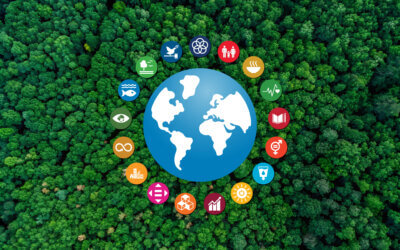From the growing body of climate change research in recent decades, it’s clear that we need to reduce atmospheric CO2 levels to avoid the most dangerous impacts of global warming.
And thanks to rising awareness, improving technology, and a lot of very dedicated people, we now have tools and knowledge to help us tackle the problem. In recent years, carbon offset projects have emerged as a very effective form of climate action, helping to reduce greenhouse gas emissions while creating and funding sustainability initiatives all over the world. These projects take many different forms, ranging from capturing methane gas from landfills, to improving and maintaining forest areas to help them absorb more carbon dioxide from the atmosphere.
You may have heard about Microsoft’s headline-grabbing plan to become carbon-negative by 2030, in which the tech giant will remove more CO2 than it has ever created, going all the back to 1975. Microsoft claims to have been carbon-neutral since 2012, but has now decided to take things a step further by actively removing all of its associated greenhouse gases.
“It is an ambitious – even audacious – goal, but science tells us that it’s a goal of fundamental importance to every person alive today and for every generation to follow.” Brad Smith, President of Microsoft
Among the climate initiatives listed in Microsoft’s strategy are projects that sequester carbon dioxide by storing it in trees and forest areas, known as “afforestation” and “reforestation”. And while these two terms sound very similar, there is one key difference:
- Afforestation: Planting new trees in an area that previously had none to create a new forest.
- Reforestation: Planting replacement trees in a forest to balance those cut down or destroyed, and then managing the area to restore natural habitats and ecosystems.
At Terrapass, we’re involved in several of these types of projects, each carefully managed and certified to ensure they have the maximum environmental impact. So, let’s take a closer look at how natural carbon sequestration works – and how it’s critical to our planet’s long-term health.
How Do Forests Reduce Global CO2 Levels?
When it comes to keeping global carbon emissions in check, forests really are a miracle of nature. Trees capture CO2 in their trunks, leaves, branches, and roots, while forest floors also store large amounts in their soil, small plants, and green “litter” spread across the surface.
Studies show that older trees absorb more carbon dioxide than their younger counterparts, as seedlings generally take five to ten years to start having a noticeable impact. And so, while it’s great for the environment to plant new trees, it’s equally beneficial to improve and maintain the health of existing forests. This dedicated management helps to maximize their carbon-absorbing potential, while also protecting them from being cleared or damaged in the future.
Forestry Management: A Long-term Commitment
Being as not all carbon offsets are created equal, it’s critical for a forestry management project to have measures in place that sustain the area over the long term. Without ongoing care and maintenance, the newly planted seedlings risk being cut down or destroyed before they have a chance to grow, completely negating their desired environmental benefit. In high-quality afforestation and reforestation projects, the sale of carbon offsets represents the captured CO2, and also funds management systems that ensure the area’s long-term health.
It’s also vital to have all forestry carbon offsets verified by a reputable 3rd party to ensure they are measurable, additional (i.e., wouldn’t have happened otherwise), and permanent. In our own projects, we regularly work with programs like the Climate Action Reserve’s (CAR) Forest Project Protocol to ensure the transparency and integrity of each carbon offset sale. It also takes longer to measure the CO2 sequestration in forests than it does in other types of projects, often requiring forestry professionals to collect regular data over many years. To that end, official certification ensures that every carbon offset sold – representing one metric ton of CO2 – has the same environmental impact as any other source, such as methane capture or farm power initiatives.
Project Spotlight: The Arcata Community Forest
One of the highly successful reforestation projects we support is the Arcata City Forest Barnum Tract in Northern California. In a critical environmental move, the city purchased the land from a timber company in 2003 after it was identified to be at risk of excessive harvesting. The area is now certified to Forest Stewardship Council (FSC) standards and absorbs 2,500 more metric tons of CO2 per year than its neighboring forests.
“FSC forest management certification confirms that the forest is being managed in a way that preserves biological diversity and benefits the lives of local people and workers, while ensuring it sustains economic viability.” Forest Stewardship Council Website
The trees are regularly checked by professional foresters to assess their health, growth, and the amount of carbon sequestered each year. The sale of carbon offsets from this project sustains the management operation, enabling the city of Arcata to maintain and improve the forest without any taxpayer funds.
And as well as absorbing more carbon dioxide from the atmosphere, the improved forest area now also provides educational and recreational opportunities for local residents. This initiative is a terrific example of how reforestation is vital in the fight against climate change – and delivers measurable benefits to communities and the thousands of plants and animals that need these areas to survive.
Join Us in Supporting Natural Carbon Removal
Whether you’re an individual wanting to make a difference or a business developing a sustainability strategy, everyone can invest in carbon offsets to help restore the natural balance. You can discover more about our portfolio of sustainability projects or use our online carbon footprint calculator to measure your annual CO2 emissions and then take action to reduce your greenhouse gases.
Climate change is a problem that affects all of us – and it’s one that we can only solve by working together and taking effective action. Restoring and sustaining our beautiful natural forests vastly improves our air, soil, and water – and ensures we leave a healthy and sustainable planet for the next generation.
Brought to you by terrapass.com
Featured image







